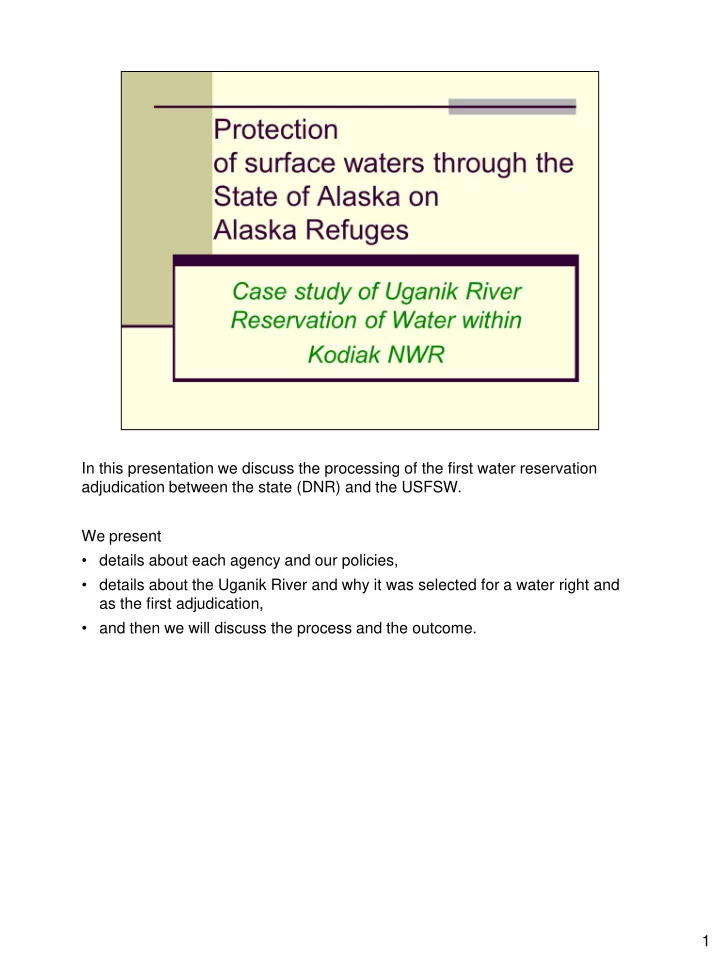

In this presentation we discuss the processing of the first water reservation adjudication between the state (DNR) and the USFSW. We present • details about each agency and our policies, • details about the Uganik River and why it was selected for a water right and as the first adjudication, • and then we will discuss the process and the outcome. 1
2
Assortment of thoughts in no particular order re Alaska and water rights. Unique, odd, peculiar, different characteristics and considerations related to instream water rights in Alaska • It is apart; does not abut another state; no possibility of interstate water dispute or need for compact or negotiation. (Some international trans-boundary issues being discussed in SE) • Lowest population density of any state (650,000 people) avg approx. 1 person/square mile vs lower 48 w/ 100 people/square mile • In contrast to most western, prior appropriation states, Alaska is not water deprived or over appropriated. • Relatively little out of stream appropriation 3
Conserve for entities other than our agencies. 4
• FWS mission statement speaks to the fact that we are primarily a conservation agency. • Our mission is to protect and enhance fish and wildlife and their habitats noting that water is essential to this mission. • And it is all done for the benefit of the American people, including citizens of the State of Alaska 5
It is an opportunity because • Of AK's progressive water • And the fact that the waters aren’t over appropriated. 6
It is the Service's policy to comply with State laws, regulations, and procedures in obtaining and protecting water rights, both for Service facilities and for trust fish and wildlife resources on lands not owned by the United States, except where application of State statutes and regulations does not permit Federal purposes to be achieved. Federal reserved water rights will be quantified and asserted when necessary to accomplish the primary purpose of the reservation. Obtain: Sufficient quantities of water and the legal right to use that water to develop, use, and manage refuge lands and facilities, protect endangered species, and maintain instream flows. Secure: All water rights needed for Service facilities and programs should be secured under State laws and procedures when available. Assert: Assert when necessary to protect federal interests in water. Review: Review and comment on notices for water right applications filed by others on or near refuges. Identify: Identify and evaluate water rights on lands proposed for acquisition or disposal. 7
8
The natural flow paradigm notes that “modifications of the natural flow regime dramatically affects both aquatic and riparian species and their habitat in streams and rivers worldwide” (Poff et al 1997) ANILCA (i) to conserve fish and wildlife populations and habitats in their natural diversity; (ii) to fulfill the international fish and wildlife treaty obligations of the United States; (iii) to provide the opportunity for continued subsistence uses by local residents; and (iv) to ensure water quality and necessary water quantity within the refuge. 9
Uganik River has 27 years of data associated with the USGS gage station 1951- 1978), fish periodicity, and biologic data associated with refuge work 10
The Kodiak NWR was originally established to protect brown bear habitat, especially feeding and breeding habitat. Conservation of brown bear and their habitat is a purpose of Kodiak NWR under ANILCA. 11
Point to Uganik Bay and the River drainage 12
Note that there are no large tributaries entering the river in the reach that contribute at a point below the point of measurement. 13
Looking upstream 14
• Include both mean and median flow as well as each year’s hydrograph to show the variability of flow • The skewed mean (of this non normal or non-parametric variable) is not representative of the true monthly “normal” flow. • the median value for a period of flow gives a better representation of the central tendency or normal of the period • The median value for a period of flow is equivalent to the fifty percent exceedance probability (Q50) which is a statistically valid representation of normal flow. 15
• Include both mean and median flow as well as each year’s hydrograph to show the variability of flow • The skewed mean (of this non normal or non-parametric variable) is not representative of the true monthly “normal” flow. • the median value for a period of flow gives a better representation of the central tendency or normal of the period • The median value for a period of flow is equivalent to the fifty percent exceedance probability (Q50) which is a statistically valid representation of normal flow. 16
17
18
• Flow determination can only result with compromise and consideration of each agencies purposes and responsibilities to the public • FWS can always top file with the state or work to settle FRWR under our policy if the adjudicated flows to do meet the purposes of the refuge 19
FWS can always top file with the state or work to settle FRWR under our policy if the adjudicated flows to do meet the purposes of the refuge 20
21
22
23
24
• Have monthly or bi-monthly meetings to keep the schedule and actions moving along; • Each party should agree to provide justification for their flow requirements and support them scientifically; • Use very clear language in all correspondence and in the application; • When a difficult issue is causing excessive calls and emails, have a meeting and clarify the Service’s and DNR’s concerns and point of view; 25
26
Recommend
More recommend